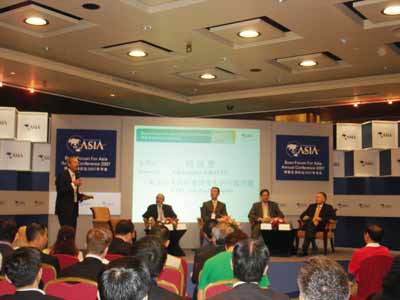| Home / Boao Forum for Asia 2007 / News Updates | Tools: Save | Print | E-mail | Most Read |
| Symbiotic Relationship Forming for India and China |
| Adjust font size: |
There is little denying that the rise of China and India has grasped the world's attention, a spotlight the two countries have kept at the Boao Forum for Asia (BFA) annual conference which concludes on Sunday night in Hainan Province.
China and India jointly account for close to 40 percent of the world's population. The sheer clout of these two countries, whether fully tapped or not, poses many questions for Asia as a whole. What roles will the continent's businesses take on the global stage, how will they ensure they stay relevant in the face of Chinese and Indian dominance and what relations will they cement with these two countries? Can a symbiotic relationship exist between China, India and the rest of Asia that would allow the continent at large to benefit from the advancements of these two awakening giants? These are the topics that business leaders sought to address at a panel discussion hosted by Christopher Graves, CEO of Asia Pacific Ogilvy Public Relations Worldwide USA. He was joined in his task by Habil Khorakiwala, president of the Federation of Indian Chambers of Commerce and Industry (FICCI); Alan Rosling, executive director of Tata Sons of India; Kenneth A Torok, president of UPS Asia Pacific and Lin Yifu, founder and director of the China Center for Economic Research of Peking University among business leaders and notables from around the world. The initial question posed by Christopher Graves gave a broad heading for the meeting: "Please paint me a picture of what Asia will look like in 2020?" Answers varied but one thread connected the opinions of all the assembled business leaders. The future of China and India dictates that appropriate strategies be created for the both of them. Many saw China cemented in its role as a global factory, a center of production while India would stand as a hub for business and IT services. However, this easy layout may be a little too convenient. According to a study conducted by Deloitte Research, China's blossoming manufacturing sector has had a range of impacts on the neighboring economies of Japan, South Korea and Southeast Asia. Japanese and Korean manufacturers have tapped into the Chinese market, profiting from its low-cost industry and high productive industry. Conversely, higher value-added processes which were initially still domestically-based are increasingly being sent to India. For Southeast Asian nations, the Chinese industry has created a wealth of opportunities for producers of raw materials and components. This phenomenon has been copied on a grander scale with many global companies turning to China with its glut of low-cost suppliers. Other Asian countries, reduced from prima donnas to under-studies, are seeking to diversify their roles and affirm their own competitive advantages. According to Habil Khorakiwala, some small and medium-sized enterprises (SMEs) see clear obstacles preventing easy access to Chinese and Indian markets. For China, the barrier is posed by finding proper channels to raise money while India lacks infrastructure. His view was taken up by economist Lin Yifu, who sees SMEs as soon developing into the most competitive sector in China and India alike. These will create diversified employment opportunities, alleviate poverty and allow sustainable economic development. Turning to China specifically, Lin highlighted "greater openness, flexibility and great investment in education" as three crucial steps necessary to the better development of China. What will the future bring for India and China? All panelists agreed that they would only continue to grow, gathering to them an ever-growing share of the global GDP. Their domestic markets will become increasingly attractive to existing global companies while both countries will create their own. All said, the best answer may lie in the result of an impromptu survey taken during the discussion which saw most respondents eagerly awaiting the benefits China and India would bring to the rest of Asia while still being wary of the hidden dangers that will accompany them. (China.org.cn by staff reporter Wang Qian, April 22, 2007) |
| Tools: Save | Print | E-mail | Most Read |
 |
| Related Stories |
